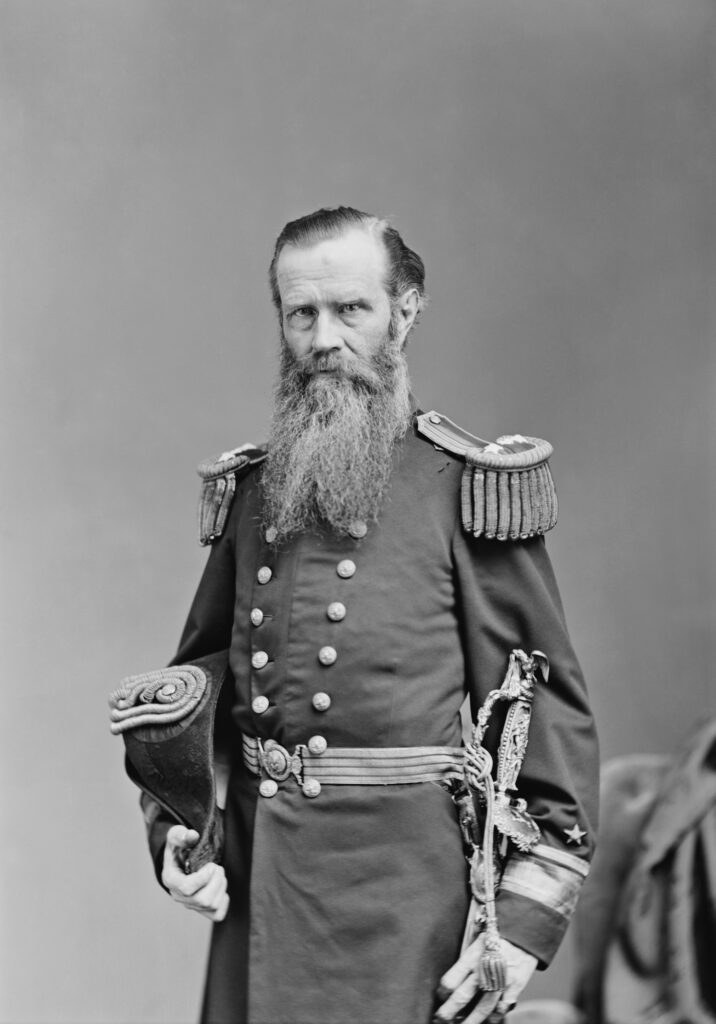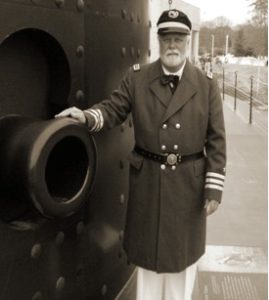
John Lorimer Worden was born in Westchester County, New York, 12 March 1818. He was appointed midshipman in the Navy on 10 January 1834. He served his first three years in the sloop-of-war Erie on the Brazil Station. Following that, he was briefly assigned to the sloop Cyane before reporting to the Naval School at Philadelphia, Pennsylvania for seven months of instruction. He returned to sea in July 1840 for two years with the Pacific Squadron. Between 1844 and 1846, Worden was stationed at the Naval Observatory in Washington, D.C. During the Mexican-American War he cruised the west coast, primarily in the store shipSouthampton. In 1850 he returned to the Naval Observatory for another two-year tour of duty. The ensuing nine years were filled with sea duty which took Worden on several cruises in the Caribbean and Mediterranean Seas.
Civil War Service
Brought to Washington early in 1861, John received orders on April 1 to carry secret dispatches-regarding the reinforcement of Fort Pickens-south to warships at Pensacola. During the return journey north, Worden became the first prisoner of war, when he was arrested near Montgomery, Alabama. He was held prisoner until exchanged about seven months later.
Taking command of the Monitor
Though still ill as a result of his imprisonment, Lieutenant Worden accepted orders to command the new ironclad Monitor on 16 January 1862. He reported to her building site at Greenpoint in Brooklyn and supervised her completion. He placed the new warship in commission at the New York Navy Yard on 25 February. On 6 March, she headed south under tow by Seth Low.
On the afternoon of 8 March, Worden’s command approached Cape Henry, Virginia, while inside Hampton Roads, the Confederacy’s own ironclad, CSS Virginia, wreaked havoc with the Union Navy’s wooden blockading fleet.
During that engagement, the Southern warship sank the sloop Cumberland and severely damaged Congress and Minnesota before retiring behind Sewell’s Point. Arriving on the scene too late to participate in the engagement, Worden and his command set about assisting the grounded Minnesota.
Battle of Hampton Roads
At daybreak on the 9th, Virginia emerged once more from behind Sewell’s Point to complete her reduction of the Federal fleet at Hampton Roads. As the Confederate ironclad approached Minnesota, Worden maneuvered the Monitor from the grounded ship’s shadow to engage Virginia in the battle that revolutionized naval warfare. For four hours, the two iron-plated ships slugged it out as they maneuvered in the narrow channel of Hampton Roads, pouring shot and shell at one another to almost no visible effect. Three hours into the slug fest, Worden received facial wounds when a Confederate shell exploded just outside the pilot house that partially blinded him. He relinquished command to his first office, Samuel D. Greene. About an hour later, the Monitor withdrew from the battle temporarily and, upon her return to the scene, found that Virginia, too, had withdrawn. The first battle between steam driven, armored ships had ended in a draw.
Other Wartime Commands
After the battle, Worden moved ashore to convalesce from his wounds. During that recuperative period, he received the accolade of a grateful nation, the official thanks of the United States Congress, and promotion to commander. Late in 1862, he took command of the ironclad Montauk and placed her in commission at New York on 14 December 1862. Later in the month, Worden took his new ship south to join the South Atlantic Blockading Squadron off Port Royal, South Carolina. On 27 January 1863, he led his ship in the bombardment of Fort McAllister. A month later, newly promoted Captain Worden took his ship into the Ogeechee River, found the Confederate privateer Rattlesnake (formerly CSS Nashville), and destroyed her with five well-placed shots. His last action came of 7 April 1863, when Montauk participated in an attack on Charleston, South Carolina.
Post-War Career and Last Years
Not long after the Charleston attack, Capt. Worden received orders to shore duty in conjunction with the construction of ironclads in New York. That assignment lasted until the late 1860s. In 1869, Commodore Worden began a five-year tour as Superintendent of the United States Naval Academy. In 1872, Worden was promoted to Rear Admiral.
During the late 1870s, he commanded the European Squadron, visiting ports in northern Europe and patrolling the eastern Mediterranean during the Russo-Turkish War of 1877-78. He returned ashore and concluded his naval career as a member of the Examining Board and as President of the Retiring Board. When he retired on 23 December 1886, Congress voted him full sea pay in his grade for life. Rear Admiral Worden resided in Washing, D.C., until his death from Pneumonia on 19 October 1897.
Thom Mitton
Capt. Thom Mitton has held a Master’s Captain License for over 25 years. He has operated yachts up to 120 ft. long from Nova Scotia to Venezuela, throughout the Bahamas and Caribbean.

Over the years, he has traversed the waters where many of the Civil War Naval Battles took place. He started his Civil War Living History with the US Christian Commission in Gettysburg, participating in Sunday’s Civil War Chapels, telling the untold stories of faith and courage during the Civil War.
Encouraged to do Civil War Naval Living History, he first became interested in the Vessels that changed Naval history, ie. USS Monitor, CSN Virginia and the Hunley submarine. He became known as the one man Civil War Navy in Gettysburg. He has expanded his knowledge to include Civil War submarines, the Naval blockade and Naval operations of the Western Rivers.
Capt Thom along with his Naval Living History displays has made presentations at the Marnier’s Museum in Newport News, VA. Gettysburg and Antietam National Parks, Regional Civil War Living History events and Round Tables.
He was recently honored by being asked to join the Confederation of Union Generals.
Capt. Thom Mitton memberships include: The Mariners Museum, The Friends of the Hunley, The Gettysburg Foundation, US Christian Commission and the US Naval Landing Party.
Capt. Thom also portrays CSA Lt Wm Alexander one of the designers of the Hunley and Capt E.J. Smith of the Titanic. He resides in Westminster, MD.
Thom Mitton can be contacted at John.Worden@uniongenerals.org.